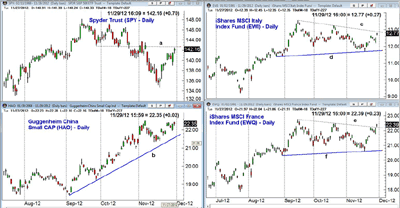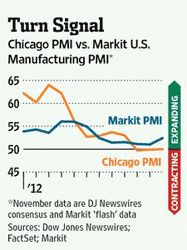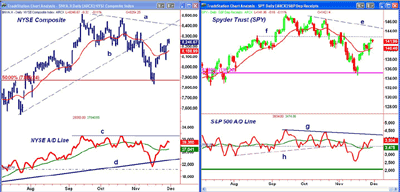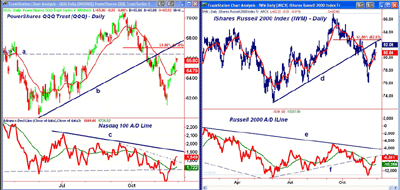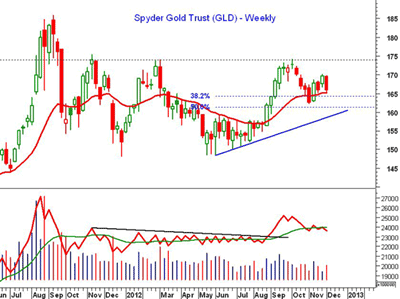Stocks continued higher for the second week in a row and the rebound has gone far enough to get the attention of many investors and traders. MoneyShow’s Tom Aspray offers a review of the major indexes and offers tips on your next moves.
The recent rally has confirmed the longer-term analysis from November 15 that concluded that the stock market had not completed a major top. The rally lost some steam on Friday, but a more convincing lower close is needed to signal that a correction is underway.
There were some signs last week that the stock market was starting to ignore the periodic negative intra-day comments on the negotiations over the fiscal cliff. This does not mean that one should get complacent as the market is likely to receive more shocks in the coming weeks from both the fiscal cliff and the always festering Euro debt crisis.
Being complacent or panicking when it comes to your investments is almost always a bad idea. I felt several weeks ago that the panic-like selling over concerns about the fiscal cliff were overdone. But now that it appears that the worst of the selling is over, what is an investor to do?
Most investments turn out poorly because the entry price was too high. Therefore I was a bit surprised when a guest Bloomberg expert Thursday afternoon advised buying the S&P 500 or the Spyder Trust (SPY), which was then trading around $142.
In the top left-hand corner of the chart above is the Spyder Trust (SPY) updated through the close on 11/29 that was not far below the strong chart resistance in the $142.50 area. Buying at this level would mean using a stop under the November low of $134.70, which has an uncomfortably high risk. That in my opinion is not being a smart buyer.
Just after the election I poised the question Should You Invest Overseas? This was because these markets were holding up better than US stocks and appeared to offer a better risk/reward opportunity.
Just under the chart of SPY is the Guggenheim China Small Cap ETF (HAO), which had good support from late October in the $21-$21.50 area and a strong uptrend, line b, from the September lows. Buying at this support with a stop under the late October lows seem to be a well controlled opportunity.
This ETF and iShares MSCI China Index Fund (MCHI) I both liked on November 13 because as I could target a buying level near support and a stop at a reasonable level. Two Eurozone ETFs also had compelling chart patterns.
On the top right is the chart is the iShares MSCI Italy Index (EWI), which a few weeks ago appeared to be forming a flag formation, lines c and d. There was well defined support in the $11.39-$11.72 area. A close above $13.25 would complete the continuation pattern with the measured target from the flag formation at $14.65.
The chart of iShares MSCI France Index (EWQ) on the bottom right looks very similar though its flag formation was completed last Thursday. A retest of the breakout level on light volume should be a buying opportunity.
NEXT PAGE: Markets Showing Mixed Signals
|pagebreak|The point is that even when the market is showing good strength it is never good to chase a stock or ETF and the correction I expect should provide additional opportunities to buy closer to support. If instead stocks continue to rally higher over the near term, don’t chase them as the market is not yet totally out of the woods.
The German parliament approved the Greece debt deal last Friday, which should facilitate the disbursement of 44 billion euros. However, the Eurozone countries have delayed further debt relief as they have not worked out how to handle their Greek exposure to Greek debts.
The economic news was mixed last week with the S&P Case-Shiller showing another month of home price increases Tuesday while durable goods orders were better than expected, they weren’t great. Consumer Confidence was strong as it reached the highest level in over four years.
This was in contrast to the disappointing new home sales as there was a the large downward revision of the September sales data. The following day we got much better data on housing as pending home sales jumped over 5%. The GDP report also came in better than expected at 2.7%
More important might be last Friday’s Chicago PMI Report, which came in at 50.4, which reflects slight growth for the first time in two months. An interesting article in the WSJ discussed the Markit Flash PMI, which looks at all of US manufacturing. In its latest reporting period, it rose to 52.4. It showed an expansion in orders, unlike the Chicago report, and the chart suggests it may be a leading indicator for the Chicago PMI.
As I mentioned two weeks ago the deterioration in Eurozone industrial production was helping to push their GDPs into negative territory. Therefore it is more important now to watch the trend in the US industrial production and manufacturing for signs of weakness.
On Monday we get new data on the manufacturing sector with the ISM Manufacturing Index as well as the PMI Manufacturing Index. Wednesday we get the ADP Employment Report, Productivity & Costs, Factory Orders, and the ISM Non-Manufacturing Index.
Thursday we get the jobless claims and Friday we get the widely anticipated jobs report as well as the preliminary University of Michigan Consumer Sentiment survey for December. All of this data should make for an interesting week.
NEXT PAGE: What to Watch
|pagebreak|What to Watch
Over the past two weeks, the tone in the stock market has clearly improved as most of the major averages made their lows on November 16 when the last column was published. At the time, though I was confident a major top had not been completed, I could not rule out another wave of selling.
I also mentioned that V-Shaped bottoms were rare and though it is possible that one was completed on November 16 this has not been confirmed. The last such bottom occurred in March 2011 in reaction to the Japanese tsunami. The Spyder Trust (SPY) dropped 7% from late February through mid-March and by late April was making new highs. Then the first pullback in 2011 retraced 38.2% of the rally from the March lows so clearly the extent of the first real setback now will be important.
The individual investors have become much more positive as 40% are now bullish as opposed to just 28.6% on October 18. There has been little movement in the newsletter writer sentiment as just over 39% are bullish with the number of bears at 27%. This has shown little change in the past seven weeks.
The 2012 Performance chart shows that despite a brief drop in mid-November that the Spyder Trust is still doing the best, up over 13%. GLD is back below SPY but still well above the performance of TLT, which is up just close to 3%. As I noted last week the bond market pros are still bullish on bonds and bearish on stocks. It has been a rough year for crude oil prices.
The daily chart of the NYSE Composite shows that the 50% Fibonacci retracement support from the June lows was tested on November 16. The two-week rally has taken the NYSE composite back to chart resistance in the 8250-8300 area with more important resistance at 8400 (lines a and b).
The NYSE Advance/Decline line dropped slightly below its longer term uptrend, line d, before rebounding. The A/D line is now back to its early November highs but needs to move convincing above the resistance at line c, and make new highs to confirm that the uptrend has resumed.
The 20-day EMA represents first support at 8150 with more important chart support now at 8000.
S&P 500
The rally in the Spyder Trust (SPY)has taken it back to the band of strong resistance in the $142.50-$143 area, line a. The 50% Fibonacci retracement resistance at $141.44 was overcome last Monday with the more important 61.8% resistance at $143.02. The downtrend from the October highs, line e, is now at $144.50.
The rally in the S&P 500 A/D line has not been that impressive as while it shows a short-term pattern of higher lows, it is still below the strong resistance from November, line g. It was also a sign of weakness that the support for the A/D line going back to August, line h, was broken on the last decline.
The daily chart has initial support now at $140.50 and the rising 20-day EMA with further at $139.60. A daily close below $138 would be the first sign that the lows could be tested.
NEXT PAGE: Sector Focus
|pagebreak|Dow Industrials
The SPDR Diamond Trust (DIA) has continued to lag the SPY as the rally has just reached the 50% retracement resistance at $130.48 and appears to have stalled well below the 61.8% Fibonacci resistance at $131.90.
The Dow Industrial A/D line (not shown) has moved back above its WMA, but is still well below the resistance that was formed during the July-October period.
There is first good support for DIA at $128.20-$129 and then in the $127 area.
Nasdaq-100
The PowerShares QQQ Trust (QQQ), which had been the weakest market sector going into the November lows, has had an impressive rebound as it has made it all the way back to the strong chart resistance at $66.20, line a. The 61.8% Fibonacci retracement resistance is at $67.05 along with the former uptrend, line b.
The sharp rally in Apple (AAPL) has played a key role as it has rallied from a low of $505 to a high last Thursday of $594.25. Those diehard apple bulls who established long positions in the stock by selling the December 520 put at $15 or better as recommended on November 12 are in a good position. I will be watching the correction in AAPL for another entry point.
The Nasdaq 100 A/D line has bounced nicely as it has broken through short-term resistance (dashed line) but is still below more important resistance at line c.
QQQ will find initial support now at $64.50-$65 with a more important low in the $63.30 area, which is the 50% retracement support.
Russell 2000
The iShares Russell 2000 Index (IWM) has rallied over 8% from its recent lows but appears to have stalled in the $82 area. The former uptrend is at $82.50 with the 61.8% retracement resistance at $82.83.
The Russell 200 A/D line has just bounced back to its former support ,now resistance, at line f. It still needs to move through the downtrend from the highs early in the year, line e, to signal a strong new market uptrend.
The daily chart shows initial support in the $80.80- $81 area and the 20-day EMA with stronger support now at $79.20-$79.50.
Sector Focus
The iShares Dow Jones Transportation (IYT) has rebounded nicely from its lows, but the longer term divergence with the Dow Industrials has still not been resolved. As I pointed out in last Friday’s column this needs to be resolved for the market to sustain a major new uptrend.
Though the Spyder Trust (SPY) looks ready to close the month unchanged there are a few standout sectors based on preliminary closing data. The Select Sector SPDR Consumer Discretionary (XLY) looks to gain almost 2.7% for the month followed by 1.6% gains in both the Select Sector SPDR Materials (XLB), Select Sector SPDR Industrials (XLI). The big losers were the Select Sector SPDR Utilities (XLU), which dropped almost 5% andthe Select Sector SPDR Energy (XLE), which was down 1.5%.
NEXT PAGE: The Week Ahead
|pagebreak|Crude Oil
The January crude-oil contract is trying to bottom in the $84-$86 area despite some wide intraday swings . A close back below the $85.30 level would weaken the base formation while a strong close above $90 would give the market a bullish bias.
Crude oil looks ready to close the year lower for the first time in three years, and I suggest everyone keep an eye on the yearly ranges for all of your key markets.
Precious Metals
Both the Spyder Gold Trust (GLD) and the iShares Silver Trust (SLV) both closed the week lower, which has certainly weakened the outlook. GLD is still holding above the 20-week EMA, but it could be broken this week.
The weekly on-balance volume (OBV) has been in a tight range for the past few week and has dropped back below its WMA. This action suggests that the action this week will be important as the failure of price to close higher this week could set the stage for a drop back to the recent lows.
The Week Ahead
The rally has been strong enough to make the bears nervous but the real test will the first correction and Friday’s mixed close is a sign that the rally is stalling. The fact that the market did reach more important resistance was enough for me to recommend light hedges last week in an inverse ETF.
The extent of the rally makes a test of the recent lows or new lows less likely now in my opinion. If the bickering in Washington gets worse (is that really possible?) then we could see another wave of selling, but I think most of it has been exhausted.
For new buying, I think one has to look for zones of support that go back more than a few days as these lows would be vulnerable to a sharp downdraft in the market. I continue to like some of the overseas markets as their charts appear to offer better opportunities.
Now that the market has rallied nicely, take some time this weekend to evaluate each of your positions and the stops you are using. For those with 401k plans, evaluate your funds to see if any switching is warranted.
- Don't forget to read Tom's latest Trading Lesson Managing Risk & Protecting Profits

